
Discover more at Bodiam Castle
Find out when Bodiam Castle is open, how to get here, the things to see and do and more.

The parkland and wider landscape around Bodiam Castle includes wetland, grassland, veteran trees and deadwood habitats, alongside archaeological features and walking routes. The combination of environments provides food, breeding sites and shelter for wildlife throughout the year, and there are plenty of species to look out for as you explore.
Put on your wellies or walking boots and head out on a walk around Bodiam Castle grounds or the nearby countryside for views across the beautiful Rother valley. Discover the woodland area on top of the west hill which has an informal den building area for families.
Walks around the grounds provide great photographic opportunities. Capture the sandstone of Bodiam Castle highlighted in the sun, its reflection in the moat, or views of the towers framed by mature trees.
Close to the castle is a pillbox from the Second World War, which was part of a line of defences along the River Rother. It was built in 1940 to slow down an advance from the south.

Please be aware of the moat and river, which have steep banks and deep water.
Find out what to look and listen for as you explore the grounds with a spotter sheet from visitor reception.
The castle moat is teeming with wildlife from carp and eels to tench and even the odd goldfish. The majority of fish are carp, including mirror, ghost and koi.
The medieval toilets would once have been emptied into the moat, and originally the carp lived in ponds elsewhere on the estate.
The banks of the moat are home to mallard ducks who love visitors. You’re likely to receive a noisy welcome from them.
Lesser stag beetles have been found in the large wood pile and rely on rotting wood above ground. The red-tailed blood bee is nationally rare but can be found at Bodiam Castle, emerging from the bare ground in spring and summer.
Tawny owls are strictly nocturnal hunters and are rarely seen during the day but have been heard here at dusk. Males and females can be heard hooting their duet calls from late autumn through the winter months and breed early in the year.
Buzzards soar above Bodiam Castle making use of the nearby open grasslands and farmland, occasionally perching on the castle’s tall oaks.
See kestrels perched on the old oak trees and the castle’s window ledges. They are cavity nesters and have been known to nest in the castle towers.
The loud, laughing call or ‘yaffle’ of the green woodpecker – the largest of the UK woodpecker species – can be heard as it re-establishes its mate in spring.
Great spotted woodpeckers can be heard mostly between March and May, drumming on dry tree branches to attract females and warn away other males. Look out for woodpecker holes in the mature trees.

Bodiam Castle has one of the most important bat roosts in the UK. In May 2013, the earliest birth of wild baby bats was recorded here, when four Daubenton’s pups were discovered.
Six bat species have been recorded at the castle: Daubenton’s, Natterer’s, brown long-eared, common and soprano pipistrelles, and serotine. Daubenton’s feed on invertebrates across the surface of water, as do Natterer’s, so the wetland habitats of the moat and River Rother at Bodiam make it an attractive place to live.
The Daubenton’s bats make up the majority of the bats at Bodiam Castle. Numbers vary year to year, but on average there are over 200 of this species, with 362 recorded in 2022. The volunteers who count the colony believe it is the largest known Daubenton’s bat maternity roost in the UK.

Find out when Bodiam Castle is open, how to get here, the things to see and do and more.
Discover the history of Bodiam Castle. Find out who built it, its royal connections and what historic graffiti can tell us about the castle’s past.

Enjoy food and drink with a view at Bodiam Castle. Shop for gifts or a souvenir of your visit and browse for the perfect pre-loved book.

Discover what to see and do at Bodiam Castle. Climb the stone towers to take in the views, learn about defending a medieval castle and explore the impressive ruins.

Bodiam Castle is a two pawprint rated place. Find out about visiting with your dog, where you can explore the castle grounds surrounding the moat together.

Plan a visit to one of the special countryside places in our care and discover the benefits of being in the great outdoors. Pack your walking boots and get ready to explore woodlands, valleys and rivers.

Discover the wide array of countryside settings around Sussex, from the highest point of East Sussex at Ditchling Beacon to the incredible rolling landscape of the South Downs.

Explore some of the finest landscapes in our care on coastal paths, accessible trails, woodland walks and everything in between. Find the best places to walk near you.
